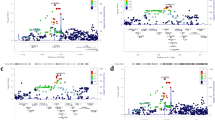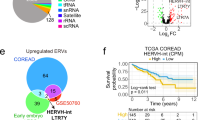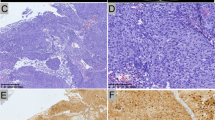Abstract
Human endogenous retrovirus (HERV) accounts for ∼8% of the human genome. Recent studies have reported that multiple HERV genes and long terminal repeats (LTRs) are involved in human tumorigenesis. Here we demonstrated that HERV-W env (syncytin-1) was overexpressed in 75.6% (62/82) of urothelial cell carcinoma (UCC) tissues of the bladder compared with only 6.1% (5/82) of matched tumor-adjacent tissues (P<0.001). Syncytin-1 overexpression increased proliferation and viability of immortalized human uroepithelial cells. Colony-formation experiments and in-vivo tumor xenografts suggested that syncytin-1 overexpression had oncogenic potential. Syncytin-1 3′-LTR mutations (142T>C and 277A>G) were present in 87.8% (72/82) of UCC tissues. Normal 3′-LTR was found in 12.2% (10/82) of UCC tissues compared with 95.1% (78/82) of matched tumor-adjacent tissues (P<0.001). Interestingly, 3′-LTR mutations were significantly associated with syncytin-1 overexpression. Luciferase assay and expression analysis revealed that 3′-LTR mutations, especially the 142T>C mutation, enhanced the syncytin-1 promoter activity and expression. In-silico analysis, electrophoretic mobility shift assays and chromatin immunoprecipitation assays demonstrated the binding of c-Myb to 3′-LTRs when the mutations occurred. This alternative interaction was found to be dependent on 142T>C mutation. C-Myb activated syncytin-1 promoter activity and expression by binding to mutant 3′-LTRs. Taken together, these data indicate that syncytin-1 overexpression may be an indicator of UCC risk. The 3′-LTR mutations may upregulate syncytin-1 expression, enabling it to participate in UCC tumorigenesis and development by interacting with c-Myb.
This is a preview of subscription content, access via your institution
Access options
Subscribe to this journal
Receive 50 print issues and online access
$259.00 per year
only $5.18 per issue
Buy this article
- Purchase on Springer Link
- Instant access to full article PDF
Prices may be subject to local taxes which are calculated during checkout










Similar content being viewed by others
References
Lander ES, Linton LM, Birren B, Nusbaum C, Zody MC, Baldwin J et al. Initial sequencing and analysis of the human genome. Nature 2001; 409: 860–921.
Strick R, Ackermann S, Langbein M, Swiatek J, Schubert SW, Hashemolhosseini S et al. Proliferation and cell-cell fusion of endometrial carcinoma are induced by the human endogenous retroviral Syncytin-1 and regulated by TGF-beta. J Mol Med (Berl) 2007; 85: 23–38.
Wang-Johanning F, Liu J, Rycaj K, Huang M, Tsai K, Rosen DG et al. Expression of multiple human endogenous retrovirus surface envelope proteins in ovarian cancer. Int J Cancer 2007; 120: 81–90.
Stauffer Y, Theiler G, Sperisen P, Lebedev Y, Jongeneel CV . Digital expression profiles of human endogenous retroviral families in normal and cancerous tissues. Cancer Immun 2004; 4: 2.
Frendo JL, Olivier D, Cheynet V, Blond JL, Bouton O, Vidaud M et al. Direct involvement of HERV-W Env glycoprotein in human trophoblast cell fusion and differentiation. Mol Cell Biol 2003; 23: 3566–3574.
Mallet F, Bouton O, Prudhomme S, Cheynet V, Oriol G, Bonnaud B et al. The endogenous retroviral locus ERVWE1 is a bona fide gene involved in hominoid placental physiology. Proc Natl Acad Sci USA 2004; 101: 1731–1736.
Bjerregaard B, Holck S, Christensen IJ, Larsson LI, Duelli D, Lazebnik Y . Syncytin is involved in breast cancer-endothelial cell fusions. Cell Mol Life Sci 2006; 63: 1906–1911.
Gimenez J, Montgiraud C, Pichon JP, Bonnaud B, Arsac M, Ruel K et al. Custom human endogenous retroviruses dedicated microarray identifies self-induced HERV-W family elements reactivated in testicular cancer upon methylation control. Nucleic Acids Res 2010; 38: 2229–2246.
Landry JR, Mager DL . Widely spaced alternative promoters, conserved between human and rodent, control expression of the Opitz syndrome gene MID1. Genomics 2002; 80: 499–508.
Sin HS, Huh JW, Kim DS, Kang DW, Min DS, Kim TH et al. Transcriptional control of the HERV-H LTR element of the GSDML gene in human tissues and cancer cells. Arch Virol 2006; 151: 1985–1994.
Romanish MT, Lock WM, van de Lagemaat LN, Dunn CA, Mager DL . Repeated recruitment of LTR retrotransposons as promoters by the anti-apoptotic locus NAIP during mammalian evolution. PLoS Genet 2007; 3: e10.
Lamprecht B, Walter K, Kreher S, Kumar R, Hummel M, Lenze D et al. Derepression of an endogenous long terminal repeat activates the CSF1R proto-oncogene in human lymphoma. Nat Med 2010; 16: 571–579.
Prudhomme S, Oriol G, Mallet F . A retroviral promoter and a cellular enhancer define a bipartite element which controls env ERVWE1 placental expression. J Virol 2004; 78: 12157–12168.
Ramsay RG, Gonda TJ . MYB function in normal and cancer cells. Nat Rev Cancer 2008; 8: 523–534.
Raman V, Martensen SA, Reisman D, Evron E, Odenwald WF, Jaffee E et al. Compromised HOXA5 function can limit p53 expression in human breast tumours. Nature 2000; 405: 974–978.
Okamoto M, Kawai K, Reznikoff CA, Oyasu R . Transformation in vitro of a nontumorigenic rat urothelial cell line by hydrogen peroxide. Cancer Res 1996; 56: 4649–4653.
Christian BJ, Loretz LJ, Oberley TD, Reznikoff CA . Characterization of human uroepithelial cells immortalized in vitro by simian virus 40. Cancer Res 1987; 47: 6066–6073.
Ruprecht K, Mayer J, Sauter M, Roemer K, Mueller-Lantzsch N . Endogenous retroviruses and cancer. Cell Mol Life Sci 2008; 65: 3366–3382.
Ahn K, Kim HS . Structural and quantitative expression analyses of HERV gene family in human tissues. Mol Cells 2009; 28: 99–103.
Zhao J, Rycaj K, Geng S, Li M, Plummer JB, Yin B et al. Expression of human endogenous retrovirus type K envelope protein is a novel candidate prognostic marker for human breast cancer. Genes Cancer 2011; 2: 914–922.
Wang-Johanning F, Frost AR, Johanning GL, Khazaeli MB, LoBuglio AF, Shaw DR et al. Expression of human endogenous retrovirus k envelope transcripts in human breast cancer. Clin Cancer Res 2001; 7: 1553–1560.
Wang-Johanning F, Frost AR, Jian B, Epp L, Lu DW, Johanning GL . Quantitation of HERV-K env gene expression and splicing in human breast cancer. Oncogene 2003; 22: 1528–1535.
Knerr I, Schnare M, Hermann K, Kausler S, Lehner M, Vogler T et al. Fusiogenic endogenous-retroviral syncytin-1 exerts anti-apoptotic functions in staurosporine-challenged CHO cells. Apoptosis 2007; 12: 37–43.
Kerbel RS, Lagarde AE, Dennis JW, Donaghue TP . Spontaneous fusion in vivo between normal host and tumor cells: possible contribution to tumor progression and metastasis studied with a lectin-resistant mutant tumor. Mol Cell Biol 1983; 3: 523–538.
Alvarez-Dolado M, Pardal R, Garcia-Verdugo JM, Fike JR, Lee HO, Pfeffer K et al. Fusion of bone-marrow-derived cells with Purkinje neurons, cardiomyocytes and hepatocytes. Nature 2003; 425: 968–973.
Rizvi AZ, Swain JR, Davies PS, Bailey AS, Decker AD, Willenbring H et al. Bone marrow-derived cells fuse with normal and transformed intestinal stem cells. Proc Natl Acad Sci USA 2006; 103: 6321–6325.
Lu X, Kang Y . Cell fusion as a hidden force in tumor progression. Cancer Res 2009; 69: 8536–8539.
Lu X, Kang Y . Cell fusion hypothesis of the cancer stem cell. Adv Exp Med Biol 2011; 714: 129–140.
Evan GI, Vousden KH . Proliferation, cell cycle and apoptosis in cancer. Nature 2001; 411: 342–348.
Perron H, Germi R, Bernard C, Garcia-Montojo M, Deluen C, Farinelli L et al. Human endogenous retrovirus type W envelope expression in blood and brain cells provides new insights into multiple sclerosis disease. Mult Scler 2012; 18: 1721–1736.
Huang W, Li S, Hu Y, Yu H, Luo F, Zhang Q et al. Implication of the env gene of the human endogenous retrovirus W family in the expression of BDNF and DRD3 and development of recent-onset schizophrenia. Schizophr Bull 2011; 37: 988–1000.
Yu C, Shen K, Lin M, Chen P, Lin C, Chang GD et al. GCMa regulates the syncytin-mediated trophoblastic fusion. J Biol Chem 2002; 277: 50062–50068.
Schubert SW, Abendroth A, Kilian K, Vogler T, Mayr B, Knerr I et al. bZIP-Type transcription factors CREB and OASIS bind and stimulate the promoter of the mammalian transcription factor GCMa/Gcm1 in trophoblast cells. Nucleic Acids Res 2008; 36: 3834–3846.
Delidaki M, Gu M, Hein A, Vatish M, Grammatopoulos DK . Interplay of cAMP and MAPK pathways in hCG secretion and fusogenic gene expression in a trophoblast cell line. Mol Cell Endocrinol 2011; 332: 213–220.
Xiao X, Li BX, Mitton B, Ikeda A, Sakamoto KM . Targeting CREB for cancer therapy: friend or foe. Curr Cancer Drug Targets 2010; 10: 384–391.
Boese A, Sauter M, Galli U, Best B, Herbst H, Mayer J et al. Human endogenous retrovirus protein cORF supports cell transformation and associates with the promyelocytic leukemia zinc finger protein. Oncogene 2000; 19: 4328–4336.
Liu F, Lei W, O'Rourke JP, Ness SA . Oncogenic mutations cause dramatic, qualitative changes in the transcriptional activity of c-Myb. Oncogene 2006; 25: 795–805.
Eble JN . World Health Organization Classification of Tumors. Pathology and Genetics of Tumours of the Urinary System and Male Genital Organs. IARC Press, France, 2004.
Edge SB . AJCC Cancer Staging Manual. Springer, USA, 2010.
Roszell AJ, Douglas CJ, Irving CC . Polyamine-stimulated growth of cultured rat urinary bladder epithelial cell. Cancer Res 1977; 37: 239–243.
Nellaker C, Yao Y, Jones-Brando L, Mallet F, Yolken RH, Karlsson H . Transactivation of elements in the human endogenous retrovirus W family by viral infection. Retrovirology 2006; 3: 44.
Chung KY, Shia J, Kemeny NE, Shah M, Schwartz GK, Tse A et al. Cetuximab shows activity in colorectal cancer patients with tumors that do not express the epidermal growth factor receptor by immunohistochemistry. J Clin Oncol 2005; 23: 1803–1810.
Doern CD, Holder RC, Reid SD . Point mutations within the streptococcal regulator of virulence (Srv) alter protein-DNA interactions and Srv function. Microbiology 2008; 154: 1998–2007.
Zhu F, Liu ZC, Li WX, Xu XL . Rapid identification of Quox-1 homeodomain DNA-binding sequence using SAAB. Biochemistry (Mosc) 2005; 70: 920–925.
Wei W, Huang W, Pan Y, Zhu F, Wu J . Functional switch of viral protein HBx on cell apoptosis, transformation, and tumorigenesis in association with oncoprotein Ras. Cancer Lett 2006; 244: 119–128.
Sali A, Blundell TL . Comparative protein modelling by satisfaction of spatial restraints. J Mol Biol 1993; 234: 779–815.
Joshi R, Passner JM, Rohs R, Jain R, Sosinsky A, Crickmore MA et al. Functional specificity of a Hox protein mediated by the recognition of minor groove structure. Cell 2007; 131: 530–543.
Tahirov TH, Sato K, Ichikawa-Iwata E, Sasaki M, Inoue-Bungo T, Shiina M et al. Mechanism of c-Myb-C/EBP beta cooperation from separated sites on a promoter. Cell 2002; 108: 57–70.
Brooks BR, Bruccoleri RE, Olafson BD, States DJ, Swaminathan S, Karplus M . CHARMM: a program for macromolecular energy, minimization, and dynamics calculations. J Comput Chem 1983; 4: 187–217.
Humphrey W, Dalke A, Schulten K . VMD: visual molecular dynamics. J Mol Graph 1996; 14: 33–38.
Phillips JC, Braun R, Wang W, Gumbart J, Tajkhorshid E, Villa E et al. Scalable molecular dynamics with NAMD. J Comput Chem 2005; 26: 1781–1802.
Mackerell AD Jr, Feig M, Brooks CL III . Extending the treatment of backbone energetics in protein force fields: limitations of gas-phase quantum mechanics in reproducing protein conformational distributions in molecular dynamics simulations. J Comput Chem 2004; 25: 1400–1415.
Luty BA, Davis ME, Tironi IG, Vangunsteren WF . A comparison of particle-particle, particle-mesh and Ewald methods for calculating electrostatic interactions. Mol Simul 1994; 14: 11–20.
Acknowledgements
We thank Wei Jin (Fudan University, Shanghai, China) for providing the plasmid pCMV-c-Myb. We would like to thank Don Banting, Awadhesh Kumar Sah and Navin Shrestha for polishing our writing. This work was supported by grants from the National Natural Sciences Foundation of China (No. 81271820, No. 30870789 and No. 30300117), the Stanley Foundation from the Stanley Medical Research Institute (SMRI), USA (No. 06R-1366) for Dr F Zhu, Hubei Provincial Natural Science Foundation for Innovative Research Team (No. 2012FFA043) and the project of Innovative Research Team of Wuhan University (No. 274041).
Author information
Authors and Affiliations
Corresponding author
Ethics declarations
Competing interests
The authors declare no conflict of interest.
Additional information
Supplementary Information accompanies this paper on the Oncogene website
Rights and permissions
About this article
Cite this article
Yu, H., Liu, T., Zhao, Z. et al. Mutations in 3′-long terminal repeat of HERV-W family in chromosome 7 upregulate syncytin-1 expression in urothelial cell carcinoma of the bladder through interacting with c-Myb. Oncogene 33, 3947–3958 (2014). https://doi.org/10.1038/onc.2013.366
Received:
Revised:
Accepted:
Published:
Issue Date:
DOI: https://doi.org/10.1038/onc.2013.366
Keywords
This article is cited by
-
Cell fusion upregulates PD-L1 expression for evasion from immunosurveillance
Cancer Gene Therapy (2024)
-
Intrinsic signalling factors associated with cancer cell-cell fusion
Cell Communication and Signaling (2023)
-
Molecular mechanisms of syncytin-1 in tumors and placental development related diseases
Discover Oncology (2023)
-
Mammalian tumor-like organs. 1. The role of tumor-like normal organs and atypical tumor organs in the evolution of development (carcino-evo-devo)
Infectious Agents and Cancer (2022)
-
Implication of human endogenous retrovirus W family envelope in hepatocellular carcinoma promotes MEK/ERK-mediated metastatic invasiveness and doxorubicin resistance
Cell Death Discovery (2021)



